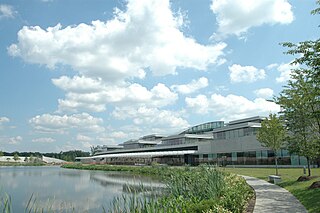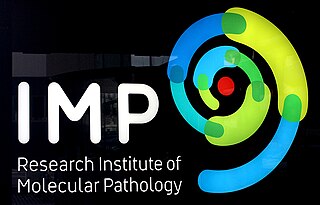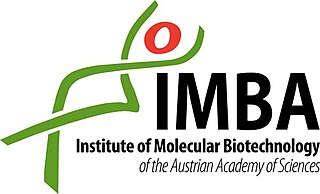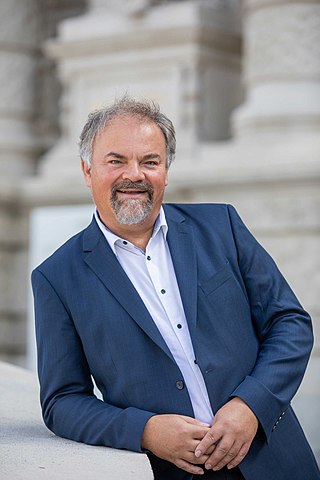
Drosophila melanogaster is a species of fly in the family Drosophilidae. The species is often referred to as the fruit fly or lesser fruit fly, or less commonly the "vinegar fly", "pomace fly", or "banana fly". In the wild, D. melanogaster are attracted to rotting fruit and fermenting beverages, and are often found in orchards, kitchens and pubs.
Charles S. Zuker is a Chilean molecular geneticist and neurobiologist. Zuker is a Professor of Biochemistry & Molecular Biophysics and a Professor of Neuroscience at Columbia University. He has been an Investigator of the Howard Hughes Medical Institute since 1989.

Janelia Research Campus is a scientific research campus of the Howard Hughes Medical Institute that opened in October 2006. The campus is located in Loudoun County, Virginia, near the town of Ashburn. It is known for its scientific research and modern architecture. The current executive director of the laboratory is Ronald Vale, who is also a vice-president of HHMI. He succeeded Gerald M. Rubin in 2020. The campus was known as "Janelia Farm Research Campus" until 2014.
Gerald Mayer Rubin is an American biologist, notable for pioneering the use of transposable P elements in genetics, and for leading the public project to sequence the Drosophila melanogaster genome. Related to his genomics work, Rubin's lab is notable for development of genetic and genomics tools and studies of signal transduction and gene regulation. Rubin also serves as a vice president of the Howard Hughes Medical Institute and executive director of the Janelia Research Campus.

Alexander "Axel" Borst is a German neurobiologist. He is director at the Max Planck Institute for Biological Intelligence and head of the department Circuits – Computation – Models.

The Research Institute of Molecular Pathology (IMP) is a biomedical research center, which conducts curiosity-driven basic research in the molecular life sciences.

The Institute of Molecular Biotechnology (IMBA) is an independent biomedical research organisation founded by the Austrian Academy of Sciences in cooperation with the pharmaceutical company Boehringer Ingelheim. The institute employs around 250 people from over 40 countries, who perform basic research. IMBA is located at the Vienna BioCenter (VBC) and shares facilities and scientific training programs with the Gregor Mendel Institute of Molecular Plant Biology (GMI) of the Austrian Academy of Sciences and the Research Institute of Molecular Pathology (IMP), the basic research center of Boehringer Ingelheim.

Michael Morris Rosbash is an American geneticist and chronobiologist. Rosbash is a professor and researcher at Brandeis University and investigator at the Howard Hughes Medical Institute. Rosbash's research group cloned the Drosophila period gene in 1984 and proposed the Transcription Translation Negative Feedback Loop for circadian clocks in 1990. In 1998, they discovered the cycle gene, clock gene, and cryptochrome photoreceptor in Drosophila through the use of forward genetics, by first identifying the phenotype of a mutant and then determining the genetics behind the mutation. Rosbash was elected to the National Academy of Sciences in 2003. Along with Michael W. Young and Jeffrey C. Hall, he was awarded the 2017 Nobel Prize in Physiology or Medicine "for their discoveries of molecular mechanisms controlling the circadian rhythm".
A Drosophila connectome is a list of neurons in the Drosophila melanogaster nervous system, and the chemical synapses between them. The fly's nervous system consists of the brain plus the ventral nerve cord, and both are known to differ considerably between male and female. Dense connectomes have been completed for the female adult brain, the male nerve cord, and the female larval stage. The available connectomes show only chemical synapses - other forms of inter-neuron communication such as gap junctions or neuromodulators are not represented. Drosophila is the most complex creature with a connectome, which had only been previously obtained for three other simpler organisms, first C. elegans. The connectomes have been obtained by the methods of neural circuit reconstruction, which over the course of many years worked up through various subsets of the fly brain to the almost full connectomes that exist today.
Amita Sehgal is a molecular biologist and chronobiologist in the Department of Neuroscience at the Perelman School of Medicine at the University of Pennsylvania. Sehgal was involved in the discovery of Drosophila TIM and many other important components of the Drosophila clock mechanism. Sehgal also played a pivotal role in the development of Drosophila as a model for the study of sleep. Her research continues to be focused on understanding the genetic basis of sleep and also how circadian systems relate to other aspects of physiology.
Patrik Verstreken is a Belgian neuroscientist, highly cited in his field. His work is focused on the function of neuronal synapses during health and neurological disease. Major contributions include identifying molecular mechanisms by which neurodegenerative diseases such as Alzheimer's disease spread throughout the brain and identification of new defects causing Parkinson's disease.
Jan-Michael Peters is a cell- and molecular biologist. Since 2013, he is Scientific Director of the Research Institute of Molecular Pathology (IMP) in Vienna.
Gregory Stephen Xavier Edward Jefferis is a British neuroscientist known for his work on the circuit basis of olfactory perception in the vinegar fly, Drosophila melanogaster. He is a tenured Programme Leader at the MRC Laboratory of Molecular Biology in Cambridge (UK) and associated with the Department of Zoology at the University of Cambridge.
James "Jim" William Truman is an American chronobiologist known for his seminal research on circadian rhythms in silkmoth (Saturniidae) eclosion, particularly the restoration of rhythm and phase following brain transplantation. He is a professor emeritus at the University of Washington and a former senior fellow at Howard Hughes Medical Institution Janelia Research Campus.

Jürgen Knoblich is a German molecular biologist. Since 2018, he is the interim Scientific Director of the Institute of Molecular Biotechnology (IMBA) of the Austrian Academy of Sciences in Vienna.

Nancy M. Bonini is an American neuroscientist and geneticist, best known for pioneering the use of Drosophila as a model organism to study neurodegeneration of the human brain. Using the Drosophila model approach, Bonini's laboratory has identified genes and pathways that are important in the development and progression of neurodegenerative diseases such as Amyotrophic lateral sclerosis, Alzheimer's disease, and Parkinson's disease, as well as aging, neural injury and regeneration, and response to environmental toxins.
Nilay Yapici is a Turkish neuroscientist at Cornell University in Ithaca, New York, where she is the Nancy and Peter Meinig Family Investigator in the Life Sciences and Adelson Sesquicentennial Fellow in the Department of Neurobiology and Behavior. Yapici studies the neural circuits underlying decision making and feeding behavior in fruit fly models.
Marta Zlatic is a Croatian neuroscientist who is group leader at the MRC Laboratory of Molecular Biology in Cambridge, UK. Her research investigates how neural circuits generate behaviour.

Time, Love, Memory: A Great Biologist and His Quest for the Origins of Behavior is a book by American non-fiction writer Jonathan Weiner, published in 1999. The book is a biography of California Institute of Technology biologist Seymour Benzer, who is recognized as one of the pioneers of genetics and molecular biology.

Stein Aerts is a Belgian bio-engineer and computational biologist. He leads the Laboratory of Computational Biology at VIB and KU Leuven, and is director of VIB.AI, the VIB Center for AI & Computational Biology. He has received several accolades for his research into the workings of the genomic regulatory code.










